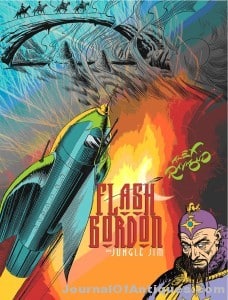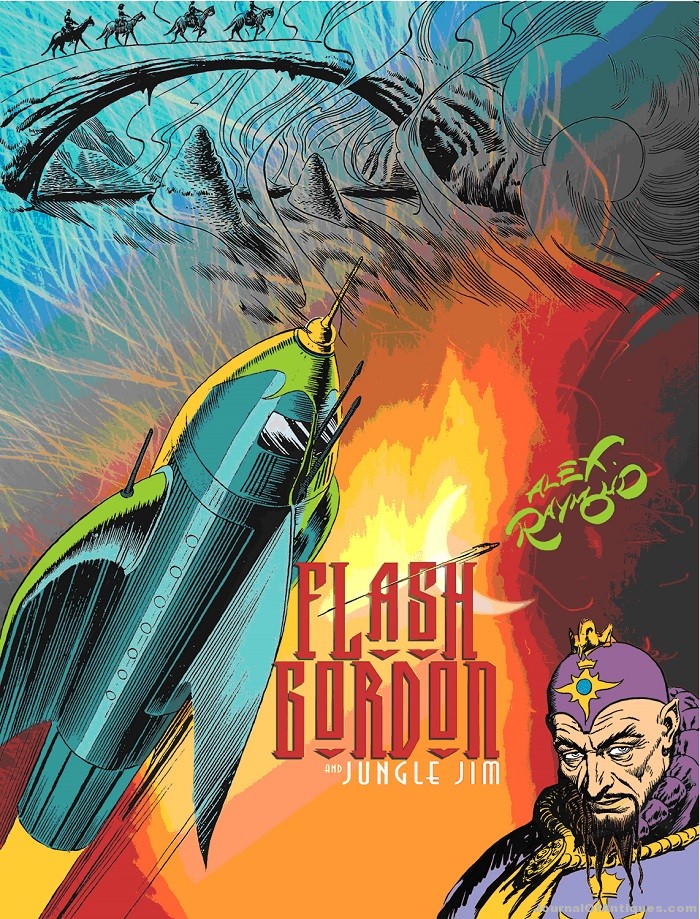Alex Raymond and the Definitive Flash Gordon and Jungle Jim
By J.C. Vaughn

More than ever, we’re living in a visual age. If those folks are happy with the state of things as they are right now, then they should by all means avoid the third volume of The Definitive Flash Gordon and Jungle Jim from IDW Publishing’s Library of American Comics (LOAC) imprint. Why? Because by including beautiful reproductions every Alex Raymond-illustrated Sunday page from March 12, 1939 through December 28, 1941 Dean Mullaney, designer Lorraine Turner, and essayist Bruce Canwell are exposing the raw nerve of the mediocrity that is the average comics section today.
That probably seems harsh. It’s by a downhill ride for newspapers ever since Calvin & Hobbs and The Farside ended, but rarely have the failings of the modern comics section been on display in such stark relief as when being compared to Flash Gordon and its topper, Jungle Jim, both the work of artist Alex Raymond.
Flash Gordon was created in response to the success of Buck Rogers and Jungle Jim in response to Tarzan, but in the hands of a master craftsman they never faired poorly by comparison. Action, adventure, beautiful women, manly men, strange worlds, and danger at every turn infused the Flash Gordon story, and while different all of those elements (except strange worlds) were also present in Jungle Jim. Raymond’s art was and is something to behold (Raymond was also known as the original artist of Secret Agent X-9, the strip created by The Maltese Falcon’s author, Dashiell Hammett).
The battles of Flash Gordon and Ming the Merciless are much better known today than the exploits of Jungle Jim, which ran as the main strip’s “topper.” Introduced by King Features Syndicate in the 1920s, toppers (which could run either above or below the main strip) ran in Sunday comic pages. Almost exclusively, they were created by the same cartoonists that did the larger feature, and they could run in the form of multi-panel strips or single-panel cartoons. While Jungle Jim was “just” a topper, it was a topper illustrated by Alex Raymond.
Unlike Tarzan, Jim’s “jungle” was not in Africa, but instead in Southeast Asia, where he and his sidekick Kolu conquered the wilds of the animal kingdom and battled river pirates and other mysteriously monstrous threats.
Written by Don Moore (who also wrote Flash Gordon), Jungle Jim was a popular enough strip to inspire a long-running radio program with voice actor Matt Crowley in the starring role and a 1936 Universal Pictures 12-part movie serial with Grant Withers in the lead role. Between 1948 and 1952, Columbia Pictures also distributed a few Jungle Jim features, starring screen Tarzan Johnny Weismuller, who later appeared in a 1955 TV series based on the character (it lasted one season).
The impact of Raymond’s work was felt almost immediately. In Bruce Canwell’s essay that introduces this volume, the late Joe Kubert, one of the seminal figures in the world of comic book art, talks about the impressions he left with after visiting in Connecticut with Raymond as a teenager from Brooklyn.
Raymond’s influence wasn’t constrained to New York and Connecticut, or even the rest of America for that matter. Growing up in Colombia, Al Williamson, who one day would become a noted Flash Gordon artist himself as well as the definitive artist on Secret Agent X-9 (then redubbed Secret Agent Corrigan).
When his parents split up and his mother decided to return to North America, Williamson wasn’t all that concerned with the differences he would experience or the situations that might confront him. He had other priorities. “This was where comics were done,” he said. “This was where Alex Raymond lived.”
In 1943 Williamson and his mother settled in San Francisco where he promptly began to devour his daily helping of Raymond’s Flash Gordon. Then the unthinkable happened. Well, unthinkable to a 12-year-old fan at any rate.
Raymond joined the war effort and his duties on the strip were taken over by Austin Briggs. No reflection on Briggs, but he just wasn’t Raymond, whose departure was not sufficiently explained. Not that any justification would have sufficed for the young Williamson.
“The next year my mother and I moved to New York. I went to the office of King Features Syndicate, owners of the strip, and demanded an explanation,” he says. He was 13 years old.
“A lady there was very nice and she offered me proofs of Briggs’ strips, but I turned them down. I suppose it wasn’t very polite, but I didn’t want them,” he says with a laugh.
Briggs’ run on Flash Gordon certainly stands on its own, but there is no denying the power, grandeur and authority of Raymond’s work or its last impact on other creators. Likewise, it’s impossible to credibly feign surprise at just how solid a production Mullaney and company put together. Whether on Little Orphan Annie, Terry and the Pirates, Bringing Up Father, Blondie or any of their other projects, they remain the gold standard by which all such efforts are judged. The oversized, 12” x 16” hardcover and its impeccable production values present just about the best way one could image to view this material.
The Definitive Flash Gordon and Jungle Jim Volume 3 is now available at comic book shops, traditional booksellers, and online bookstores. It carries a $75 cover price.
J.C. Vaughn is the Vice-President of Publishing for Gemstone Publishing. Members of the Gemstone staff contributed to this piece.





Related posts: